Infrastructure
10 Years of Smart Cities Mission
94% of projects completed, ₹1.64 lakh crore invested
Posted On: 24 JUN 2025 1:59PM
“Hundreds of small cities have a key role in achieving the resolve of a developed India by 2047. Our government is upgrading basic facilities in such urban centres to improve ease of living.”
- Prime Minister Narendra Modi
Key Takeaways
- 94% of the total 8,067 projects under Smart Cities Mission have been completed, with ₹1.64 lakh crore invested.
- Cities followed area-based and pan-city approaches to improve infrastructure and services.
- All 100 cities have Integrated Command and Control Centres using tech like Artificial Intelligence and Internet of Things for better city management.
- Thousands of smart roads, cycle tracks, classrooms, and health centres have been built.
- Initiatives like Cycles4Change and Streets4People promoted open spaces and inclusivity.
Introduction

The Smart Cities Mission (SCM) aims to enhance the quality of life in India's cities through smart, sustainable solutions. Its goal is to create cities that are economically vibrant, inclusive and environment friendly. By focusing on key areas like infrastructure, governance and social development, SCM seeks to transform urban living across the country.
Launched on June 25, 2015 by Prime Minister Narendra Modi, the Smart Cities Mission aims to improve the quality of life in 100 cities by providing efficient services, robust infrastructure, and sustainable solutions. Focused on economic growth, inclusivity, and sustainability, it addresses diverse needs such as housing, transport, education, healthcare, and recreation, with the goal of creating adaptable urban spaces that serve as models for other cities.
With 100 cities driving the initiative, the Smart Cities Mission has achieved substantial progress. As of May 9, 2025, a total of 7,555 projects—94% of the total 8,067 projects—have been completed, amounting to ₹1,51,361 crore. Additionally, 512 projects worth ₹13,043 crore are in the advanced stages of implementation. This amounts to overall 8,067 multi-sectoral projects valued at ₹1.64 lakh crore.
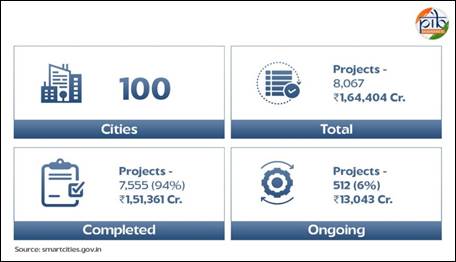
The total allocated union budget for the Smart Cities Mission was ₹47,652 crore. By March 31, 2025, 99.44% of the total budgeted outlay has been released to 100 cities in the mission. The centre’s share is supplemented by other sources of funding such as contributions by the state governments, urban local bodies, public-private partnerships, etc., making the total investment 1.64 lakh crores.
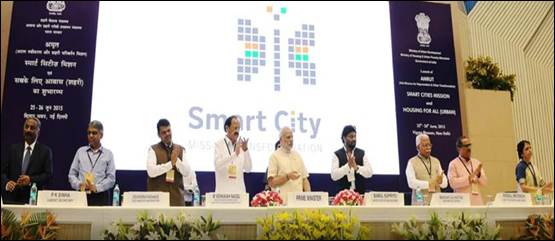
Source: smartcities.gov.in
Approach of this Mission
The implementation of the Smart Cities Mission primarily follows two key approaches. First, under the Smart Cities Mission, cities are being developed using an Area-Based Development (ABD) approach, where each of the 100 cities has selected a defined area for targeted interventions. These ABD areas, chosen through citizen participation, are being developed as replicable models for other parts of the city.
Second, every city has included Pan-City Projects, which are technology-driven solutions to make infrastructure and services better. For example, Chandigarh has implemented India’s largest and densest pan-city Public Bicycle Sharing (PBS) system with 310 docking stations and over 2,500 bicycles. The PBS system has contributed to reducing traffic congestion and promoting public health.
Other key dimension of the mission includes creating a Special Purpose Vehicle (SPV) structure for programme implementation, promoting multiple sources of funding for projects and engaging citizens.
Key Achievements of this Mission
As of May 9, 2025, 94% of the total 8,067 projects have been successfully completed, reflecting significant progress in reshaping urban landscapes across India.
Below are some key initiatives and milestones achieved by SCM (As of March 31, 2025):
Integrated Command and Control Centres (ICCC): All 100 Smart Cities have operational ICCCs, which utilize data for making informed decisions. These ICCCs also functioned as COVID war rooms during the pandemic and have significantly improved city operations such as transport, water supply, and solid waste management by integrating emerging technologies like AI, IoT, and Data Analytics.
Public Safety and Security: Over 84,000 CCTV surveillance cameras have been installed in 100 Smart Cities, aiding in crime monitoring. Additionally, 1,884 emergency call boxes, 3,000 public address systems, and traffic enforcement systems for red light violations and automatic number plate recognition have been installed, enhancing public safety.
Water Supply: 28 cities have developed drinking water treatment capacity of 2,900+ million litres per day (MLD). More than 17,026 km of the water supply system are being monitored through SCADA, reducing non-revenue water and leakages.
Vibrant Public Spaces: More than 1,320 projects on public spaces have been developed across 84 smart cities, including 318 km of waterfront development by 62 smart cities. Additionally, 55 smart cities have completed the conservation of 484 heritage monuments while 58 cities have undertaken market redevelopment projects.
Sewerage: 27 cities have created wastewater treatment capacity of 1,370 MLD, of which 673 MLD is being reused for different purposes like gardening, industrial usage, etc.
Solid Waste Management: Over 66 cities are managing solid waste with increased technology use, improving route management, efficiency of collection, and daily management. Around 9,194 vehicles have been RFID-enabled for Automatic Vehicle Location (AVL) to digitize and improve solid waste management efficiency.
Mobility: Over 1,740 km of smart roads have been constructed or improved, and 713 km of cycle tracks have been developed. Around 23,000 bicycles and over 1,500 buses have been procured and over 2,000 bus stops have been developed. 177 Smart Mobility projects were completed in the FY 2024-25. Furthermore, an Intelligent Transport Management System (ITMS) has been implemented and is being monitored through ICCCs, improving traffic operations, enforcing traffic violations, and reducing journey time.
Education: 9,433 smart classrooms have been developed across 2,300 government schools in 71 smart cities. Further, 41 digital libraries have also been developed.
Health: 172 e-health centers and clinics (without dedicated beds) have been developed, and 152 health ATMs also have been installed. 15 cities have developed e-Health record keeping system.
Adopting to Emerging Needs and Overcoming Challenges
In addition to the core initiatives, the Smart Cities Mission has introduced projects in response to emerging challenges. For example, in the wake of the COVID-19 pandemic, campaigns like ‘Cycles4Change’ and ‘Streets4People’ were launched to promote open spaces for active living. To ensure inclusive access to public spaces, initiatives such as the ‘Placemaking Marathons’ and ‘Nurturing Neighbourhoods Challenge’ focused on vulnerable groups. Other challenges, like ‘Transport4All’ and ‘EatSmart Cities’ aim to support public transport startups and improve food hygiene in smart cities.
Strategies for Smart City Mission
The Smart Cities Mission seeks to boost economic growth and enhance the quality of life by promoting local area development and utilizing technology for smart outcomes. The approach involves transforming existing areas through retrofitting and redevelopment, developing new areas through greenfield projects, and implementing smart solutions across the city with Pan-city initiatives. Each city's proposal must include one of the area-based models (retrofitting, redevelopment, or greenfield development) along with a Pan-city feature to ensure inclusivity and benefits for all residents. In North Eastern and Himalayan states, the development area requirements are reduced by half.
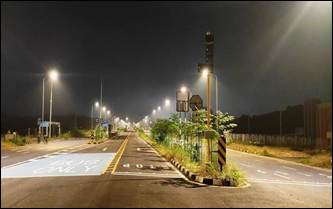
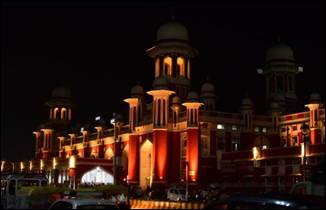
Transport Circulation has been enhanced in Smart City Ranchi Redevelopment of 100-year-old Charbagh Railway Station by
Smart City Lucknow
Success Stories of Smart Cities
Visakhapatnam
- Solar Street Lights: Visakhapatnam Smart City has installed 380 standalone solar streetlights (44W each) and 200 solar post lights (25W each), covering key areas like the 5 km beach stretch and ABD zone. This initiative generates 189.4 MWh of clean energy annually, cuts carbon emissions by 242 tons, and saves ₹12 lakh in electricity costs every year.
- All-Abilities Park: Visakhapatnam’s “All-abilities” park offers an inclusive space with wheelchair-friendly paths, ramps, and sensory play zones for differently abled children. Its accessible design promotes equitable use of public spaces and sets a model for other cities to follow.
Udaipur
- Solid Waste Management System: Udaipur introduced 49 auto-tippers and built a 20-tonne capacity waste transfer station, along with a 20 TPD biomethanation plant and 30 TPD wet waste processing plant. These interventions reclaimed 32,830 square meter of land, enabled compost and biogas generation, reduced fuel and transport costs, and helped the city move towards self-sustainability in waste management.
- Sewerage Treatment Plants (STPs): Three new STPs of 25, 10, and 5 Megaliters/day (MLD) capacity, worth ₹80 crore, were built using advanced SBR technology and automated systems under the Hybrid Annuity Model. These plants help to reduce disease spread, enable reuse of sludge in agriculture, and support environmental sustainability through recycling.
Kakinada
- Integrated Command and Control Centre (ICCC): Kakinada’s Integrated Command and Control Centre (ICCC) enhances urban governance through real-time monitoring of traffic, air quality, and public services using 34 digital boards, adaptive signals, and smart poles.
- IIFT Kakiknada: India’s 3rd Indian Institute of Foreign Trade (IIFT) is being constructed in Kakinada, after Kolkata and Delhi. The construction and finishing work is almost complete as on February 2025.
Solapur
- E-Toilets: To eradicate the practice of open defecation, Solapur Smart City has set up E-Toilets across the city. An E-Toilet uses utilizes electronic and automated features like self-cleaning, and often incorporate features like automated access control, sensor-based water and electricity conservation, and remote monitoring capabilities.
- Redevelopment of Indira Gandhi Stadium: The redevelopment of Indira Gandhi Stadium in Solapur was completed at a cost of ₹24 crore. It transformed 2.36 lakh sq. ft. of space with 11 main pitches, 6 practice pitches, modern drainage, and upgraded pavilion and media facilities, enabling it to host major tournaments like Ranji Trophy, Cooch Behar Trophy, and U-19 women’s matches.
Coimbatore
- Clean Energy: Coimbatore replaced over 97,000 streetlights with LED lamps and installed solar plants and rooftop systems generating over 8 MW, leading to annual energy savings of nearly 1.5 crore KWh and cost savings of ₹9.67 crore. The city promotes renewable power for municipal operations and provides free electricity up to 100 KWh to urban poor households.
- Rejuvenation of 7 Lake System: Coimbatore rejuvenated seven polluted and encroached lakes, restoring 28 acres of land and enhancing flood resilience, ecological balance, and public recreation through amphitheatres, water sports, birdwatching, and NMT corridors. The project improved per capita public space from 2.17 sq m to 4.9 sq m and rehabilitated 7,680 households with secure tenements.
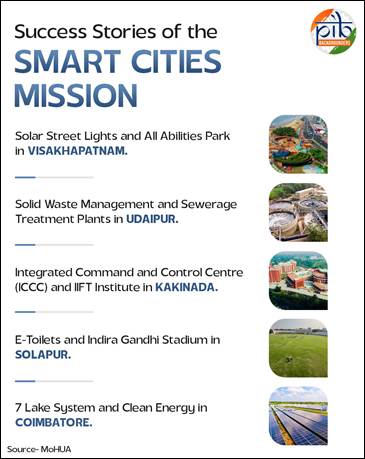
Conclusion
The Smart Cities Mission has made great progress in improving cities across India. Through smart technology, sustainable solutions, and active community involvement, the mission has enhanced infrastructure, public safety, mobility, water supply, and healthcare. Additionally, it has adapted to new challenges, like promoting open spaces and safer transport, through initiatives such as ‘Cycles4Change’ and ‘Streets4People.’ As the mission moves forward, it continues to work towards building smarter, more livable cities that can serve as examples for others to follow.
References
Ministry of Housing and Urban Affairs
https://smartcities.gov.in/
https://www.ksccl.in/#
https://mohua.gov.in/cms/smart-cities.php
https://x.com/SmartCities_HUA/status/1204006276155543552
https://pib.gov.in/PressReleasePage.aspx?PRID=2083808
https://smartcities.gov.in/sites/default/files/2023-09/SCM_UN_Report%20.pdf
https://smartcities.gov.in/sites/default/files/2023-09/NL%2011%20Sep%20293%20issue.pdf
https://smartcities.gov.in/sites/default/files/2024-12/Smart%20City%20Book_Udaipur_Compressed.pdf
https://smartcities.gov.in/sites/default/files/2023-09/Compendium%20of%20Best%20Practices_book_web_version_1.pdf
Ministry of Commerce
https://www.commerce.gov.in/wp-content/uploads/2025/02/LS-USQ-No.262-dated.-04.02.2025.pdf
PIB Backgrounder
Enhancing Urban Life: https://pib.gov.in/PressNoteDetails.aspx?NoteId=151908
Niti Ayog
https://abp.championsofchange.gov.in/content/248all-abilities-park-in-visakhapatnam-a-model-for-inclusive-open-spaces
*****
10 Years of Smart Cities Mission
Santosh Kumar | Ritu Kataria | Rishita Aggarwal
(Backgrounder ID: 154736)
Visitor Counter : 89
Read this release in:
Hindi